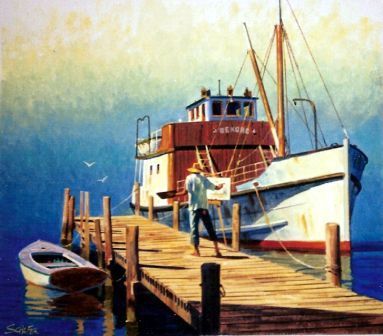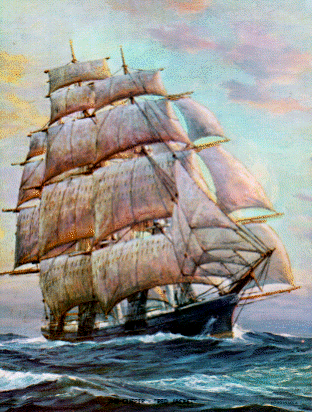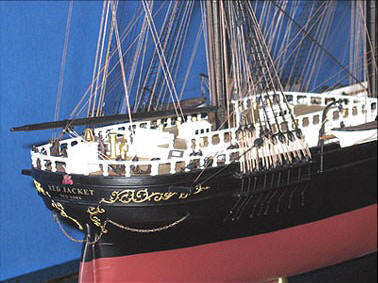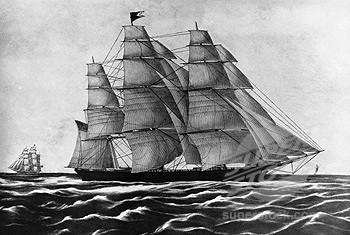
&
&
&
The Extreme Clipper Ship
Red Jacket

to Liverpool in 13 days, one hour, twenty five minuets
That was Rocket Science in 1854.
Captain Jim raises a life sized midsection section of frame for display,
graphically showing the enormity of the size of the Clipper Red Jacket.
In July of 2008, the staff and volunteers of the Sail, Power & Steam Museum in Rockland erected a full-scale model of the center frame from the historic clipper ship Red Jacket alongside the Boat House at Sharp's Point South. The frame was drafted by marine illustrator Sam Manning and the stock was hand-hewn to scale by Atlantic Challenge apprentices. Currently on loan from the Penobscot Marine Museum, the frame model is now available to view seven days a week, year-round.
But
what is the history of the Red Jacket?
Who was her first skipper?
Why was she named after a coat?
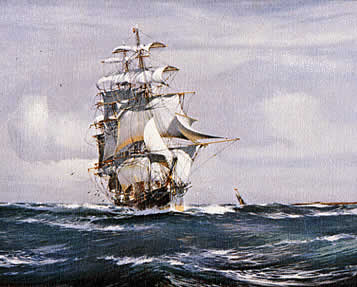
Why was she known as the "swiftest clipper of her time"
The clipper ship Red Jacket, named after a Native American Chief of the Seneca Tribe, was unquestionably the sharpest, fastest and best looking of the Maine fleet of sail vessels. Chief Otetiani, also called Sagoyewatha, which in native language means �He keeps them awake,� earned his name for the red coat that he wore, a sign of his allegiance to the British during the American Revolution. He later made peace with the newly formed United States and in 1792 he was presented a medal by General George Washington. Chief Red Jacket died in 1830 on a reservation in Buffalo, New York at the age of 72. However, the sleek vessel that later bore his name was not built on the ways in his native state of New York, she was constructed in the State of Maine.
Red Jacket�s keel was laid in the shipyard of �Deacon� George Thomas, in the North-end of Rockland, Maine near the site of the present day Atlantic Challenge. She was designed by Samuel H. Pook, a naval architect, and was built for the firm of Seacomb & Taylor in Boston. According to �The Clipper Ship Era� by Arthur H. Clark, published c. 1910, she was 260 feet in length, had a 44 foot beam, a draft of 26 feet and weighed in at 2,305 tons*
.
Red Jacket's first master, Captain Osa Eldridge, was from a family of seafaring brothers on Cape Cod. Her initial crew, 60 in number, was made up mostly of land-lubbers, and bar room riffraff. Fortunately she had a staff of fine officers. Her maiden voyage departed from Sandy Hook, NY on January 11, 1854. After a stormy trans-Atlantic crossing they passed Rock Light off Liverpool, England in a record time of 13 days, 1 hour and 25 minutes. Due to the rough weather, she only averaged 182 nautical miles a day for the first week, but for the final six days she averaged 353 miles in each 24 hour period. Capt. Eldridge then, refusing the aid of a tug, sailed her up the Mersey River to a Liverpool dock, threw her yards aback and, with precision that brought a roar from the awaiting crowd, lay the vessel alongside the pier head. It was a feat of no small magnitude.
The Red Jacket created a sensation as the public came down to the docks in droves to inspect the vessel�s sleek lines and incredible figurehead and the transom, which also featured an elaborate carving of her namesake.
Capt. Elbridge remained with the Collins Lines and turned over Red Jacket�s helm to Capt. Samuel Reid. Eldridge then sailed as Master of the Pacific in the Far East trade until the vessel he was commanding was lost at sea with all hands in 1855.
Red Jacket�s next voyage under Capt. Reid, was from Liverpool to Melbourne, Australia in a respectable 69 days. She made the return trip in 73 days in spite of time lost negotiating the ice fields of Cape Horn.
After this voyage she was sold to Pilkington & Wilson, agents for the White Star Line, for a reported thirty thousand English pounds. She continued the Melbourne run carrying passengers and general cargo outbound and gold dust and passengers on the return. When the Australian passenger trade began to slow she was used to carry general cargo in various trades including a run between Quebec and Liverpool carrying timber in the 1870s.
Red Jacket was last sold in 1883 to Blandy Brothers, a Portuguese shipping company in the Madeira Islands. She was unceremoniously stripped of her masts and rigging and spent her last days as a coal hulk. In a storm on December 15, 1885 she parted her moorings and was wrecked ashore. A few parts of the Red Jacket were saved, but there isn�t any known record of the salvage of her striking figurehead or the ornate and garish array of stern carvings.
The Red Jacket, pride of Rockland�s shipwrights, a true �Greyhound of the Sea,� had a short 32 years of sailing. She was surely a victim of the bottom-line, as more cost effective ships were being put into service. Still, the skilled boat builders of the Rockland area deserve much credit for producing such a seaworthy and able craft. Her record for the fastest trans-Atlantic crossing by a commercial sailing vessel remains unbroken to this day�more than 150 years after it was established.
Mr. Clark listed her tonnage as 2006 tons, while multiple sources list it as 2305 tons.
** The common abbreviation for forecastle; a section near the bow where crew were housed.
Red Jacket under a cloud of canvas
Length Overall: 260 feet
Beam: 44 feet
Draft: 26 feet
Tonnage: 2305 tons
Designer: Samuel H. Pook, N.A.
Builder: �Deacon� George Thomas
Date of Launch: November 2, 1853
Place of Launch: Rockland, Maine
Date of Loss: December 15, 1885
Place of Loss: Madeira Islands
The Sail, Power and Steam Museum
Rockland, Maine
Click here
email us at ssmuseum@midcoast.com
75 Mechanic Street, Rockland,
Maine 04843
Captain Jim Sharp
207-701-7627

